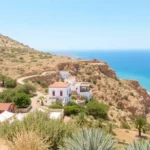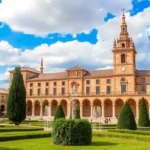Top 15 Things to See and Do in the Murcia Region

- Exploring Murcia: The Capital City
- Cartagena: The Historical Gem
- Natural Wonders: Gredas de Bolnuevo
- Lorca: A City with a Medieval Castle
- Discovering the Valle de Ricote
- Cieza and Its Blossoms
- Calasparra: A Culinary Delight
- Natural Attractions: Salto del Usero
- Calblanque Regional Park: A Coastal Paradise
- Cabo de Palos: A Historic Lighthouse
- Adventure in Sierra Espuña
- Geological Marvel: Barranco de Gebas
- The Historic Village of Aledo
- Explore the Cueva del Puerto
- Wine Country: Jumilla
- A Map of Must-Visit Places in the Region of Murcia
- More Places to Explore in the Region of Murcia
Small but mighty: that’s the Region of Murcia. If you don't believe it, keep reading to discover the 15 best things to see and do in the Murcia region. Situated in the southeastern corner of Spain, this region may seem a bit isolated, but it hides a plethora of surprises that offer a rich cultural, gastronomic, and scenic heritage. And let’s not forget its 300 days of sunshine a year!
Exploring Murcia: The Capital City
We begin our adventure in the capital, Murcia, the seventh-largest city in Spain, often overlooked by tourists. However, did you know that it’s one of the leading destinations for Street Art? Its vibrant murals and creative expressions can be found scattered throughout the city. Additionally, Murcia boasts one of the country’s most stunning cathedrals, a must-visit for architecture enthusiasts.
But it doesn’t stop there; the city is famous for its tapas, which are truly unforgettable. From patatas bravas to local specialties like zarangollo, the culinary scene here will tantalize your taste buds.
→ Here’s a detailed guide on what to see and do in Murcia city.
Cartagena: The Historical Gem
A significant reason Murcia may not get the attention it deserves is Cartagena, a city that draws all eyes with its rich history. The highlight here is the impressive Roman Theatre, which lay hidden beneath the city for centuries until its discovery during construction works. It is now considered the crown jewel of ancient Carthage.
To fully appreciate its history, we recommend taking a free tour that showcases the many attractions of this ancient Roman city.
For budget accommodations in Murcia, you can find options here.
Natural Wonders: Gredas de Bolnuevo
If you prefer landscapes sculpted by nature rather than human hands, visit the Bolnuevo Beach. Its unique rock formations are the result of wind and water erosion, creating a surreal scene known as the Gredas de Bolnuevo, reminiscent of a mystical world.
Don’t miss the chance to explore Mazarrón and its port, rich in Phoenician history—here, ancient shipwrecks have been found, adding intrigue to the coastal town’s allure. If you’re an adventure seeker, consider joining a kayak tour to experience the stunning coastline from the water.
Lorca: A City with a Medieval Castle
Lorca, also known as the City of the Sun, is famous for its abundant sunshine and its magnificent Castle of Lorca, perched high on a hill. This medieval fortress played a crucial role in the historical conflicts between Muslims and Christians, thanks to its formidable structure.
You can now visit the castle for a small fee (10€) or even spend a night at its Parador de Turismo. Take the opportunity to explore the rest of the town, which boasts several churches, palaces, and intriguing museums. Additionally, you can wander through the remains of an ancient Jewish quarter.
Discovering the Valle de Ricote
The Valle de Ricote is one of the most charming spots in the Murcia region. Known as the Morisco Valley, it still feels infused with its Arabic heritage. Visitors can enjoy picturesque landscapes typical of the Segura River basin and explore quaint villages like Abarán, Blanca, Ojós, Ricote, and Archena.
Moreover, don’t miss one of Spain’s most valued spas, the Archena Spa, located in Archena, where you can relax and rejuvenate.
Cieza and Its Blossoms
Before leaving the Valle de Ricote, a stop in Cieza is essential, especially if your visit falls between February and March. This is when the fruit trees bloom, cloaking the landscape in a beautiful pink hue that rivals even the famous hanami in Japan, albeit with peach trees instead of cherry blossoms.
→ To witness this stunning sight, consider joining a guided tour.
Cieza also offers the opportunity to explore the Almadenes Canyon, a breathtaking gorge approximately 4 km long and 150 meters deep, ideal for river descents or scenic hiking routes.
Calasparra: A Culinary Delight
Next up is Calasparra, renowned for its exquisite rice—one of the most sought-after varieties on the market. Here, you can visit the Santuario de la Virgen de la Esperanza, the local patron saint, which is carved into the rock and situated about 6 km from the town.
Natural Attractions: Salto del Usero
Another natural gem in the Murcia region is the Salto del Usero, located in Bullas. This natural pool has formed through the erosion of the Mula River, making it a perfect spot for a family day out. However, be aware that during the summer, access requires a paid reservation. More info here.
Calblanque Regional Park: A Coastal Paradise
Covering about 250 km of coastline, the Calblanque Regional Park is a true paradise. Among its many stunning beaches, the Calblanque Beach stands out as a favorite, known for its unspoiled beauty, golden sands, and crystal-clear waters. In our opinion, it’s the best beach in Murcia and one of the top things to do in the Murcia region.
Cabo de Palos: A Historic Lighthouse
Just 7 km away lies Cabo de Palos and its iconic lighthouse, a cultural heritage site since 2002. This location was a silent witness to the largest naval battle of the Spanish Civil War, the Battle of Cabo de Palos.
While there, take a seat at one of the local restaurants, such as Restaurante Miramar or El Mosqui, and savor the caldero del Mar Menor, a traditional Murcian dish. If you’re into diving, the waters of the Cabo de Palos and Hormigas Islands Marine Reserve are among the best in Europe, featuring the sunken ship "Naranjito."
Adventure in Sierra Espuña
Another must-visit location in the Murcia region is the Sierra Espuña, a regional park in the heart of the community. Here, you can embark on numerous activities such as hiking along various trails (like the El Berro Trail or the Umbría del Bosque Trail), climb to the summit of Sierra Espuña at 1,583 meters, or enjoy picturesque views like the Sierra de la Muela and the Leyva Walls.
Additionally, wildlife enthusiasts will be delighted to spot various bird species (over 100!), as well as amphibians and mammals, including the endemic Espuña squirrel, making it one of the top things to see in Murcia.
Geological Marvel: Barranco de Gebas
Not far from there, you’ll find another photogenic spot: the Barranco de Gebas. Here, you might feel as though you’ve jumped to the Moon, with its semi-arid desert landscape surrounded by badlands.
However, the Algeciras River Reservoir, with its turquoise waters, will quickly remind you that you are still in Spain!
The Historic Village of Aledo
Aledo is a small village at the foot of Sierra Espuña, noted for its Homage Tower, a formidable fortress that served as a defensive stronghold during the Middle Ages and now houses the tourist information office.
If possible, try to visit Aledo during the "Night of the Candles" in August, when the old town is illuminated by thousands of candles, creating a magical atmosphere.
Explore the Cueva del Puerto
You don’t need to be a cave enthusiast to be amazed by the Cueva del Puerto. Spanning around 800 meters, it is the largest cave in Murcia. On a guided tour, you’ll encounter stunning rock formations, false floors, and halls filled with stalactites, immersing you in a hidden world.
This is a perfect family-friendly activity, with the tour lasting about an hour. You can book your visit here.
Wine Country: Jumilla
Jumilla is another charming village in Murcia, notable for its castle and its rich history influenced by Iberian, Roman, and Arab traditions. It's also famous for its wines, particularly those with Denomination of Origin, making it an appealing destination for wine lovers. Exploring Jumilla is one of the best things to do in the Murcia region.
Together with Bullas and Yecla, Jumilla forms a spectacular wine route that you shouldn’t miss if you appreciate fine wines. The loop takes around three hours, but allow extra time if you want to visit several wineries and points of interest.
A Map of Must-Visit Places in the Region of Murcia
To help you navigate the rich tapestry of attractions in the Murcia region, here’s a handy map highlighting key locations. This will make your journey even more enjoyable and well-planned.
More Places to Explore in the Region of Murcia
Of course, there are many more places to visit in the Region of Murcia, including the Monastery of the Jerónimos (the Murcian Escorial), the villages of Moratalla and Caravaca de la Cruz, and the stunning views from the Battery of Castillitos. Then there’s the Manga del Mar Menor, which unfortunately isn’t in the best condition at the moment, but we hope this iconic attraction will bounce back soon.
Have we missed any fundamental things to see and do in the Murcia region? Feel free to let us know!
| Save on your trip |
| Compare and find cheap flights here |
| Find accommodations at the best prices here |
| Book activities and excursions in English here |
| 5% discount on your travel insurance with IATI here |
| Reserve transfers from the airport here |
| Get a €10 gift when booking transport across Europe here |
| Learn how to withdraw money without commissions here |
| 5% discount on your eSIM from Holafly here |
| Rent a car with the best deals here |
| Compare prices for van rentals here |
| The best books and travel guides here |
| All our articles about Spain |
* Photocredit: Shutterstock






Deja una respuesta